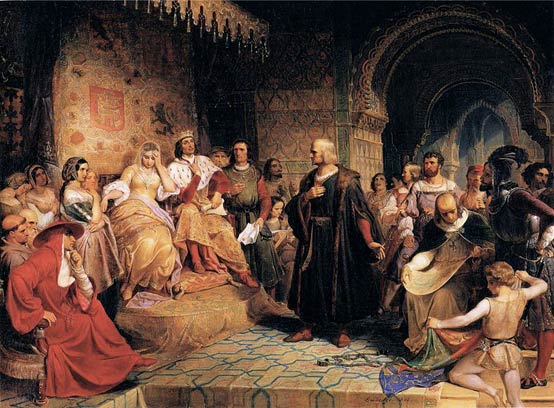The Columbus Myth
The name Christopher Columbus is the Anglicization of the Latin Christophorus Columbus. His name in Italian is Cristoforo Colombo and in Spanish Cristóbal Colón. The story of Columbus is not at all that we have been told. This article is not written to infer that Columbus did not travel to America; there is plenty of historical evidence to establish that fact. The chapter does, however, validate that by the time Columbus made his voyage, both North and South America had been explored surveyed and claimed by two separate European nations and that Spain had knowledge of this fact. This chapter will also prove that Spain had plans to conquer Mesoamerica (Central America) even before Columbus began his voyage. Based on this information, the story that Cortez invaded Mesoamerica on his own, without permission from Spain is most likely not true.
The Quest for Support
In 1485 AD, Columbus presented his plans to John II, King of Portugal to cross the Atlantic. He proposed that the king equips three sturdy ships and grant Columbus one year’s time to sail out into the Atlantic, search for a western route to the Orient, and return. Columbus also requested that he be made “Great Admiral of the Ocean”, appointed the governor of any and all lands he discovered, and given one-tenth of all revenue from those lands. The king submitted Columbus’s proposal to his experts, who rejected it. It was their considered opinion that Columbus’s estimation of a travel distance of 2,400 miles (3,860 km) was, in fact, far too low. The true reason for the denial was that Portugal did not want their colonies in South America discovered, until after the current war to reclaim the Iberian Peninsula from the Muslims was over. It is not a coincidence that Portuguese is the native language of Brazil.
In 1488 AD, Columbus appealed to the court of Portugal once again, and once again, John II invited him to an audience. King John again showed no interest in Columbus’s far-fetched project. Columbus traveled from Portugal to both Genoa and Venice, but he did not receive encouragement from either. Columbus had also dispatched his brother Bartholomew to the court of Henry VII of England, to inquire whether the English crown might sponsor his expedition, but also without success.
Columbus then sought an audience with the monarchs Ferdinand II of Aragon and Isabella I of Castile, who had united many kingdoms in the Iberian Peninsula by marrying, and now, by ruling together. On 1 May 1486, Columbus received permission to see Queen Isabella. Columbus presented his plans to the Queen, who, in turn, referred it to a committee. After the passing of much time, the experts of Spain, like their counterparts in Portugal, replied that Columbus had grossly underestimated the distance to Asia. They pronounced the idea impractical and advised their Royal Highnesses to pass on the proposed venture.

‘Columbus Before the Queen’ (1843) by Emanuel Gottlieb Leutze. Image source: Wikipedia
However, to keep Columbus from taking his ideas elsewhere, the Spanish Monarchs gave him an annual allowance of 12,000 Maravedis and, in 1489 AD, furnished him with a letter ordering all cities and towns under their domain to provide him food and lodging at no cost. This was a full 6 years prior to the departure of Columbus for the “New World”. In reality, this was a contingency plan by the Vatican, Spain and Portugal. They now knew that Columbus was very serious about crossing the Atlantic. If he was successful he would have discovered the Portuguese, Mayan, Aztec and Masonic colonies already in the Americas. The Portuguese and Spain needed a tactic to delay his departure until they had finished their war against the Moors (Muslims). Once the war was over they could divert their resources to protecting their interests in the Americas.
On January 2, 1492, the last Muslim leader, Muhammad XII, known as Boabdil to the Spanish, surrendered complete control of Granada, to Ferdinand and Isabella, Los Reyes Católicos (“The Catholic Monarchs”). The re-conquest (Reconquista) of Iberia was complete.
On the evening of August 3, 1492, AD, Columbus departed from Palos de la Frontera with three ships: a larger carrack, the Santa María (A Galician ship), and two smaller caravels, the Pinta (Meaning painted), and the Santa Clara, nicknamed the Niña (Meaning little girl) after her owner, Juan Niño of Moguer. The monarchs forced the Palos inhabitants to contribute to the expedition. The Santa María was owned by Juan de la Cosa and captained by Columbus. The Pinta and the Niña were piloted by the Pinzón brothers (Martín Alonso and Vicente Yáñez). The ship the Santa Maria was not only a Galician ship, owned by Juan de la Cosa, who after the voyage was responsible for printing the now famous map called the “Juan de la Cosa Map”. The map was printed c1500 and shows 25 ancient geoglyphic survey markers that currently exist on the North and South American Continent. These geoglyphs would have taken centuries to explore and construct. Could both the North and South American Continents have been explored from coast to coast in the 8 years between the voyage of Columbus and the printing of the map? I think you already know the answer. (“Ancient Signposts” – Amazon.com, 2011)
The post The Columbus Myth appeared first on LewRockwell.
Leave a Reply